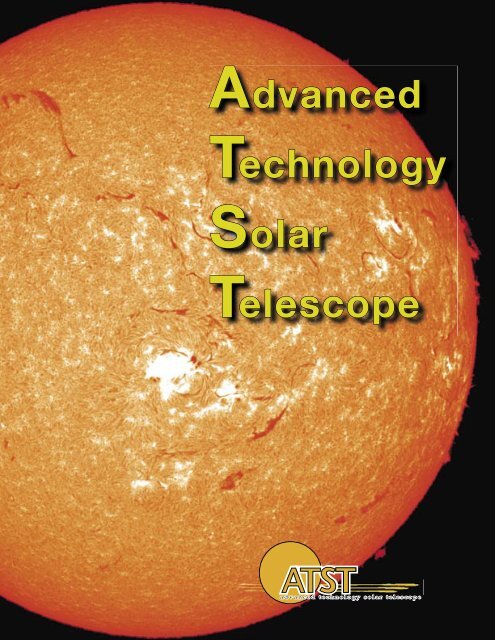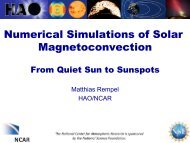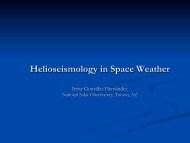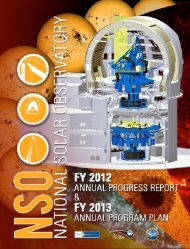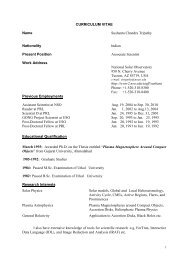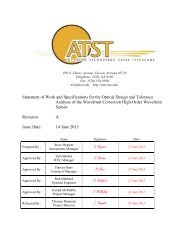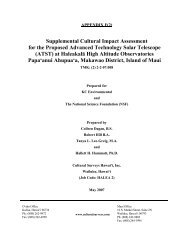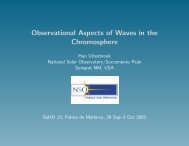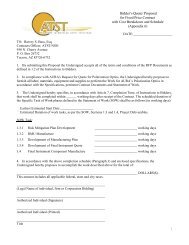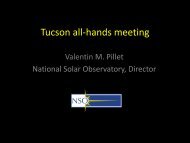The Science of ATST - National Solar Observatory
The Science of ATST - National Solar Observatory
The Science of ATST - National Solar Observatory
You also want an ePaper? Increase the reach of your titles
YUMPU automatically turns print PDFs into web optimized ePapers that Google loves.
Advanced<br />
Technology<br />
<strong>Solar</strong><br />
Telescope<br />
a d v a n c e d t e c h n o l o g y s o l a r t e l e s c o p e
Inside front cover<br />
left blank
Advanced Technology <strong>Solar</strong> Telescope<br />
<strong>The</strong> Need: We are positioned for a new era <strong>of</strong> discovery about the Sun and the subtle ways it affects life on Earth. To<br />
embark on this journey we must observe the Sun and its magnetic activities at higher spectral, spatial, and temporal<br />
resolutions that will be made possible with the 4-meter Advanced Technology <strong>Solar</strong> Telescope (<strong>ATST</strong>).<br />
1<br />
Getting the fi ne structures to see the big picture: Where modern telescopes can resolve features the size <strong>of</strong> the<br />
state <strong>of</strong> Texas, <strong>ATST</strong> — using adaptive optics — will be able to resolve features as small as counties, 30 to 70 km<br />
(18-42 mi) across, and thus reveal the fi ne aspects <strong>of</strong> activities that control an entire star.<br />
3<br />
<strong>The</strong> <strong>Science</strong>: We now see the Sun as a complex <strong>of</strong> electrifi ed gases whose shape and fl ow are controlled by<br />
magnetic fi elds. <strong>ATST</strong> will study the outer solar atmosphere where magnetic activities manifest themselves as sunspots<br />
and other changing phenomena that can affect life on Earth.<br />
4<br />
Sun and Climate: Discoveries that the solar constant varies — indeed, some aspects vary daily — sheds new light<br />
on our understanding <strong>of</strong> how the Sun warms our home planet, and drives the need to understand those periods<br />
when solar variations have dramatically altered terrestrial climate.<br />
5<br />
<strong>ATST</strong> and the many colors <strong>of</strong> the Sun: <strong>ATST</strong> will take advantage <strong>of</strong> the full spectrum <strong>of</strong> solar radiation that is<br />
passed by Earth’s atmosphere, from near ultraviolet through deep infrared, to provide powerful diagnostics <strong>of</strong> solar<br />
activities.<br />
8<br />
Looking beyond the Sun: Mysteries <strong>of</strong> the Sun are also illuminated by studying other stars, both sunlike and<br />
beyond, just as astrophysics is enriched by using our Sun as a model for phenomena that cannot be resolved with<br />
current instruments.<br />
10<br />
<strong>The</strong> Telescope: <strong>ATST</strong> will be a world-class, 4-meter (13.1 ft) optical telescope that will serve the solar physics<br />
community to the middle <strong>of</strong> the 21st century and beyond. It will host an array <strong>of</strong> instruments — many using technologies<br />
still in the laboratory— and incorporate a world-class solar physics institute.<br />
11<br />
Smoothing the wrinkles out <strong>of</strong> our view <strong>of</strong> the Sun: Large solar telescopes have not been practical because <strong>of</strong><br />
limits imposed by atmospheric turbulence. Adaptive optics technologies can compensate for much <strong>of</strong> atmospheric<br />
blurring and produce sharp images and spectra at faster rates.<br />
13<br />
<strong>The</strong> <strong>ATST</strong> Team: <strong>ATST</strong> is being developed by a consortium led by the NSO and comprising the University <strong>of</strong> Chicago,<br />
New Jersey Institute <strong>of</strong> Technology, University <strong>of</strong> Hawaii, and the High Altitude <strong>Observatory</strong>, plus elements <strong>of</strong><br />
NASA, the U.S. Air Force, and other private and public institutions.<br />
17<br />
1/2 relative size<br />
Michigan State University<br />
AURA<br />
Advanced Technology <strong>Solar</strong> Telescope<br />
Collaborating Institutions<br />
<strong>National</strong> <strong>Solar</strong> <strong>Observatory</strong><br />
High Altitude <strong>Observatory</strong><br />
New Jersey Institute <strong>of</strong> Technology<br />
University <strong>of</strong> Hawaii<br />
University <strong>of</strong> Chicago<br />
University <strong>of</strong> Rochester<br />
University <strong>of</strong> Colorado<br />
University <strong>of</strong> California Los Angeles<br />
University <strong>of</strong> California San Diego<br />
California Institute <strong>of</strong> Technology<br />
Princeton University<br />
Stanford University<br />
Montana State University<br />
California State University Northridge<br />
Harvard-Smithsonian Center for Astrophysics<br />
Colorado Research Associates<br />
Southwest Research Institution<br />
Air Force Research Laboratory<br />
Lockheed Martin<br />
NASA/Goddard Space Flight Center<br />
NASA/Marshall Space Flight Center<br />
<strong>The</strong> <strong>National</strong> <strong>Solar</strong> <strong>Observatory</strong>: As the nation’s premier solar physics institution, the NSO provides international<br />
leadership in observing the Sun and in developing advanced new instruments, and <strong>of</strong>fers research opportunities<br />
from high school through post-graduate studies.<br />
<strong>National</strong> <strong>Solar</strong> <strong>Observatory</strong><br />
P.O. Box 62<br />
950 N. Cherry Avenue<br />
Sunspot, NM 88349-0062 Tucson, AZ 85719-4933<br />
505-434-7000 520-318-8000<br />
http://atst.nso.edu or http://www.nso.edu<br />
<strong>The</strong> <strong>National</strong> <strong>Solar</strong> <strong>Observatory</strong> operates under a cooperative agreement between the Association <strong>of</strong> Universities for<br />
Research in Astronomy, Inc. (AURA) and the <strong>National</strong> <strong>Science</strong> Foundation. © 2003 <strong>National</strong> <strong>Solar</strong> <strong>Observatory</strong><br />
18<br />
Cover photo: <strong>The</strong> Sun in H as seen by the U.S. Air Force Improved <strong>Solar</strong> Optical Observing Network (ISOON) facility located at NSO’s Sunspot,<br />
NM, site. Chapters in this book show the progression <strong>of</strong> the active region at center on April 30, May 1 (on the cover), and May 2, 2003.
Cross-section<br />
<strong>of</strong> outer solar atmosphere<br />
Relative size <strong>of</strong> Earth<br />
12,723 km (7,908 mi) diameter<br />
Corona<br />
Millions <strong>of</strong> kilometers into space<br />
> 1 million K (1.8 million ˚F)<br />
Transition region<br />
~50-100 km (32-62 mi) deep,<br />
rapid heating<br />
Corona<br />
Anatomy <strong>of</strong> the Sun<br />
Transition region,<br />
Chromosphere, { Photosphere<br />
Core<br />
Flare<br />
Coronal<br />
mass<br />
ejection<br />
At 1.4 million km, the Sun is 109 times wider<br />
than Earth, yet much <strong>of</strong> what we know about its<br />
interior comes from what we can see through<br />
its outer atmosphere, as depicted here. Fusion<br />
occurs only in the core; heat and energy move<br />
through the radiative zone, and then drive the<br />
convection zone. <strong>The</strong>se are concealed by view.<br />
We can only observe the photosphere, chromosphere,<br />
and transition region — with a combined<br />
depth less than 1/250th the radius <strong>of</strong> the Sun<br />
(thinner even than the diameter <strong>of</strong> Earth). We can<br />
also observe the corona and activities like fl ares<br />
and coronal mass ejections which cross several<br />
layers at once.<br />
NASA/Marshall Space Flight Center<br />
Extended magnetic fi eld lines arcing<br />
through the chromosphere and into the<br />
corona can reconnect, causing an explosive<br />
fl are and/or releasing a coronal<br />
mass ejection (CME) into deep space.<br />
Before onset<br />
Confined eruption, ending<br />
Eruption onset<br />
Ejective eruption, middle<br />
Radiative zone<br />
Convective zone<br />
NSO/AURA/NSF<br />
NASA/Transition Region and Coronal Explorer (1),<br />
Bart De Pontieu, Swedish Vacuum Telescope (3-4)<br />
1<br />
2<br />
3<br />
4<br />
Seen only during solar eclipses or with special<br />
telescopes, the faint corona is the Sun’s tenuous<br />
outer atmosphere and extends deep into space.<br />
One <strong>of</strong> the mysteries <strong>of</strong> modern solar physics<br />
is why the solar atmosphere suddenly soars in<br />
temperature in a thin transition region between<br />
the lower corona and the chromosphere. Coronal<br />
events are closely linked to magnetic activities<br />
in the lower atmosphere.<br />
<strong>The</strong> chromosphere emits and absorbs a wide<br />
range <strong>of</strong> colors as temperatures and pressure<br />
change. Yet through its depth, we can see how<br />
magnetic fi elds link features from the corona<br />
to the visible surface even as they twist and<br />
change, as outlined by the inset image at far left.<br />
At immediate left, an abbreviated representation<br />
<strong>of</strong> layers <strong>of</strong> the atmosphere depicts 1) extreme<br />
ultraviolet from iron (17.1 nm) at the bottom <strong>of</strong><br />
the corona, 2) H (hydrogen-alpha; 656.3 nm)<br />
tracing out solar active regions, 3) calcium II K<br />
(393 nm) showing magnetic fi elds, and 4) G-<br />
band (430 nm) revealing features in the “visible<br />
surface.” In general, each spectral line relates to<br />
a specifi c temperature and thus the altitude <strong>of</strong><br />
the source.<br />
Chromosphere<br />
~2,000-3,000 km (~1,243-1,864 mi) deep<br />
~6,000-10,000 K (~10,340-17,540 ˚F)<br />
Photosphere (“visible surface”)<br />
~400 km (~240 mi) deep<br />
~5,780 K (~9,944 ˚F)<br />
<strong>Solar</strong> interior<br />
~696,000 km (~432,567 mi) to center<br />
~15.7 million K (~28.3 million ˚F)<br />
NASA/ESA SOHO Consortium<br />
NSO/AURA/NSF<br />
Gas inside the Sun is so dense that it reabsorbs<br />
light as quickly as it is emitted. <strong>The</strong> density<br />
decreases with distance from the surface until<br />
light at last can travel freely and thus gives the<br />
illusion <strong>of</strong> a “visible surface.” Escaping light also<br />
cools the gas, setting up granular circulation<br />
cells like an immense boiling pot (enlarged inset<br />
<strong>of</strong> sunspot). Magnetic lines also emerge from the<br />
interior, suppressing convection (lower image)<br />
and forming sunspots <strong>of</strong> cool gas that <strong>of</strong>ten are<br />
larger than Earth (size indicated by black circle<br />
below inset).<br />
Heights and temperatures are approximate and variable; colors, shapes<br />
and positions are illustrative.
<strong>The</strong> Need<br />
Since George Ellery Hale’s 1908 discovery that sunspots<br />
coincide with strong magnetic fields, we have become<br />
increasingly aware <strong>of</strong> the Sun’s magnetic fields as an complex<br />
and subtle system. <strong>The</strong> familiar 11-year sunspot cycle<br />
is just the most obvious <strong>of</strong> its many manifestations. Recent<br />
advances in ground-based instrumentation have shown<br />
that sunspots and other large-scale phenomena that affect<br />
life on Earth are intricately related to small-scale magnetic<br />
processes whose inner workings are beyond what current<br />
telescopes can observe.<br />
At the same time, using advances in computer science<br />
and technology, scientists have developed intriguing<br />
new theories about those small-scale processes, but<br />
without real-world observational data to verify their<br />
models. We are positioned for a new era <strong>of</strong> discovery<br />
about the Sun and how it affects life on Earth, how distant<br />
stars work, and how we might control plasmas in<br />
laboratories.<br />
To embark on that journey, we must observe the Sun<br />
and its magnetic activities at higher resolutions on three<br />
fronts:<br />
• Spatial — resolve fundamental scales <strong>of</strong> structures on<br />
the solar surface and in its atmosphere,<br />
• Spectral — narrow slices <strong>of</strong> the solar spectrum for better<br />
measurements <strong>of</strong> magnetic fields and thermodynamics,<br />
and<br />
• Temporal — high cadence (frequent) images and spectra<br />
<strong>of</strong> rapidly developing events.<br />
Further, we must observe not just in familiar near-ultraviolet<br />
and visible light, but exploit the relatively unexplored<br />
infrared solar spectrum. We must see the faint solar<br />
corona in infrared, measure the polarization <strong>of</strong> sunlight<br />
with greater precision, and cover a large field <strong>of</strong> view so<br />
extended active areas can be studied. <strong>The</strong>se capabilities will<br />
reveal hidden aspects <strong>of</strong> magnetic activities and help us<br />
bridge the gap from what we know now to what we must<br />
learn. But doing so requires a large telescope to overcome<br />
limitations imposed by current instruments.<br />
NSO’s long range plan recognizes that progress in understanding<br />
the Sun requires that it be treated as a global<br />
system, in which critical processes occur on all scales, from<br />
the very small (
NSO/AURA/NSF<br />
Adaptive optics (AO) is the leading technical advance that makes large-aperture solar telescopes practical. At the heart <strong>of</strong> such systems are<br />
thin, deformable mirrors (like the one at right <strong>of</strong> center) teamed with advanced s<strong>of</strong>tware to iron out the wrinkles in our view <strong>of</strong> the Sun. While<br />
AO made large astronomical telescopes possible starting in the 1980s, solving the problem for the Sun has been an engineering challenge<br />
that we have met only in the last few years (page 13).<br />
spectrally narrow subset <strong>of</strong> the available light. This is like<br />
looking through a microscope and switching to higher<br />
powers and inserting a color filter: as you get closer to the<br />
answer, you also reduce the available light, eventually close<br />
to blackout.<br />
Also like their nighttime counterparts, solar physicists<br />
cope with atmospheric “seeing.” Looking through Earth’s<br />
atmosphere is like looking from the bottom <strong>of</strong> a swimming<br />
pool. Without corrective measures, current ground-based<br />
solar telescopes can reveal structures no smaller than a few<br />
hundred kilometers across on the surface <strong>of</strong> the Sun.<br />
A larger telescope can solve photon starvation, but<br />
atmospheric seeing would limit it to the same spatial<br />
<strong>ATST</strong> specifications<br />
Aperture 4 m (13.1 ft)<br />
Configuration Gregorian, <strong>of</strong>f-axis<br />
Mount Altitude-Azimuth (Alt-Az)<br />
Enclosure Ventilated corotating hybrid dome<br />
Field <strong>of</strong> view Goal: 5 arc-min (300 arc-sec)<br />
Minimum: 3 arc-min (180 arc-sec)<br />
Image quality Seeing limited (no AO): under excellent seeing conditions,<br />
0.3 @ = 500 nm<br />
Spectral range 300-28,000 nm (0.3-28 µm)<br />
Polarization Accuracy: >10 -4 <strong>of</strong> continuum intensity<br />
Sensitivity: 10 -5 continuum intensity (limited by photon<br />
statistics)<br />
Coronagraphic Near infrared through infrared<br />
Scattered light
Simulation<br />
0.”03 resolution<br />
(@550 nm, w/AO)<br />
0.1<br />
1” resolution<br />
(@550 nm,<br />
uncorrected)<br />
1<br />
<strong>ATST</strong><br />
(2010)<br />
Scale (arc-seconds)<br />
10<br />
100<br />
300” field <strong>of</strong> view<br />
SDO<br />
(2005)<br />
(2004)<br />
STEREO<br />
SOLIS (2004)<br />
FASR: Frequency-Agile <strong>Solar</strong><br />
Radiotelescope<br />
SDO: <strong>Solar</strong> Dynamics <strong>Observatory</strong><br />
SOLIS: Synoptic Optical Long-term<br />
Investigations <strong>of</strong> the Sun<br />
STEREO: <strong>Solar</strong>-Terrestrial Relations<br />
<strong>Observatory</strong><br />
FASR<br />
(2010)<br />
1000<br />
1,920” disk<br />
1920<br />
EUV UV VIS NIR FIR <strong>The</strong>rmal Radio<br />
nm<br />
10 eV<br />
While many solar telescopes observe the whole solar disk, most<br />
studies, including those planned for <strong>ATST</strong>, glean new knowledge<br />
from small areas <strong>of</strong> the sun. <strong>ATST</strong> will have a large fi eld <strong>of</strong> view<br />
— up to 300 arc-seconds (5 arc-minutes) out <strong>of</strong> an average solar<br />
diameter <strong>of</strong> 1,920 arc-seconds —and will resolve down to 0.03 arcseconds<br />
in visible light (550 nm). This will reveal features as small as<br />
20 to 70 km wide at the solar surface. Atmospheric turbulence limits<br />
ground-based telescopes — without adaptive optics (see page 13)<br />
— to a resolution <strong>of</strong> about 1 arc-seconds, regardless <strong>of</strong> the size <strong>of</strong><br />
the telescope, and occasionally permits 0.5 arc-seconds for short<br />
periods. By comparison, the human eye has a fi eld <strong>of</strong> view about<br />
263 times wider than the Sun (~140 degrees) and a resolution <strong>of</strong><br />
60 arc-seconds. Getting to such a level <strong>of</strong> detail is but a means to<br />
an end: Resolving fundamental astrophysical processes in the solar<br />
atmosphere.<br />
Specifi cally, scientists want to see down to the intrinsic scale, the<br />
distance atoms and molecules move as these processes take place<br />
at high temperatures. Two key measures <strong>of</strong> the intrinsic scale are<br />
the distance light travels before being reabsorbed by another atom<br />
(photon mean-free path) and the height across which atmospheric<br />
pressure changes by a certain constant (pressure scale height). To<br />
resolve these fundamental length scales in the deepest accessible<br />
layers <strong>of</strong> the solar atmosphere requires seeing structures as small as<br />
70 km (42 mi) at the solar surface (an angular resolution <strong>of</strong> 0.1 arcsecond<br />
or better).<br />
Getting the fine structures to see the big picture<br />
m<br />
1 THz<br />
mm<br />
1 GHz<br />
However, modern numerical simulations with a resolution <strong>of</strong><br />
10 km plus inference from the best available images suggest<br />
even smaller scales for crucial physical processes such as vortex<br />
flows, dissipation <strong>of</strong> magnetic fields, and magnetohydrodynamic<br />
(MHD) waves. Resolving these scales is <strong>of</strong> utmost importance<br />
to testing various physical models and thus understanding<br />
how the physics <strong>of</strong> the small scales ties into the larger problems.<br />
An example is the question <strong>of</strong> what causes slight variations <strong>of</strong> the<br />
solar radiative output — the solar constant — that impacts the terrestrial<br />
climate. <strong>Solar</strong> radiation received at Earth increases with solar<br />
activity (see page 5). Since the smallest magnetic elements contribute<br />
most to this fl ux excess, it is <strong>of</strong> particular importance to study<br />
and understand the physical properties <strong>of</strong> these dynamic structures.<br />
Unfortunately, the 0.76 to 1.5-meter apertures <strong>of</strong> present solar telescopes<br />
cannot provide measurements at such scales because <strong>of</strong><br />
their limited apertures.<br />
Further, because <strong>of</strong> the need to provide an observatory that can<br />
operate for decades and incorporate new technologies as they<br />
become available, <strong>ATST</strong> needs to be ground-based. While space<br />
(with no atmosphere to absorb or blur light) <strong>of</strong>fers the best possible<br />
seeing conditions for observing the Sun, planets, and the rest <strong>of</strong><br />
the universe, size and technical evolution argue against building an<br />
orbital <strong>ATST</strong>. Many <strong>of</strong> <strong>ATST</strong>’s new instruments will be require fi netuning<br />
or frequent updates on site, while others will be added years<br />
later as new detector technologies emerge. On-orbit servicing and<br />
replacement are not affordable for a program like <strong>ATST</strong>.<br />
Finally, <strong>ATST</strong> will not operate alone. Just as a symphony cannot<br />
be appreciated by listening to one instrument, the Sun cannot<br />
be understood by observing just in visible light. <strong>ATST</strong> will work in<br />
concert with satellites and other ground-based observatories, such<br />
as SDO, STEREO, SOLIS (which will be co-located with <strong>ATST</strong>), the<br />
proposed FASR observatory, and others.<br />
U.S. Air Force ISOON (Sun), Applied Physics Laboratory/Johns Hopkins University (STEREO), New Jersey Institute <strong>of</strong> Technology (FASR), NSO/AURA/NSF (all others)<br />
3
<strong>The</strong> <strong>Science</strong><br />
Hale’s discovery in 1908 that magnetic fields permeate<br />
sunspots started a revolution that turned solar<br />
science into a field encompassing (and <strong>of</strong>ten advancing)<br />
many branches <strong>of</strong> physics. In particular, much <strong>of</strong> our solar<br />
research now involves magnetohydrodynamics (MHD),<br />
the study <strong>of</strong> plasmas (electrically conducting gases) whose<br />
shapes and flows are influenced by magnetic fields.<br />
Sunspots, it turns out, are the best-known manifestations<br />
<strong>of</strong> large magnetic system found in the outer third or<br />
so <strong>of</strong> the Sun. Hydrogen fusion, the source <strong>of</strong> the Sun’s<br />
energy, occurs only in the core. <strong>The</strong> remainder <strong>of</strong> the Sun<br />
is a massive blanket serving two roles. First, it compresses<br />
the core to keep fusion going, and moderates the flow <strong>of</strong><br />
energy from the core into space. <strong>The</strong> outer region <strong>of</strong> the<br />
blanket is the convective zone where giant gas cells circulate<br />
like water in a boiling pot, bringing heat to the surface.<br />
At the same time, solar rotation moves the cells around the<br />
Sun, somewhat like massive weather systems. Because the<br />
gas is electrically conducting, this motion produces a series<br />
<strong>of</strong> massive dynamos generating magnetic fields that stretch<br />
and shear, disconnect and reconnect.<br />
cool. When the gas density drops so light can travel freely,<br />
it forms what we see as the visible “surface” <strong>of</strong> the Sun,<br />
the photosphere. Here twisted magnetic fields loop out<br />
<strong>of</strong> the convective zone, into space and back to form an array<br />
<strong>of</strong> features, including sunspots, plages, filaments, and<br />
prominences. Magnetic fields reach through the overlying<br />
chromosphere and into the corona where they can become<br />
unstable and trigger coronal mass ejections, or simply open<br />
into interplanetary space. When massive fields pierce the<br />
visible surface they <strong>of</strong>ten form darkened areas — sunspots<br />
— where the magnetic field keeps hot gas from rising from<br />
the interior.<br />
All these affect life on Earth. <strong>The</strong> 11-year sunspot<br />
cycle (actually a 22-year magnetic cycle) is one <strong>of</strong> the better-known<br />
phenomena. But the various forces that drive<br />
the cycle, and determine its intensity and its relationship<br />
with conditions around and on Earth, remain poorly understood.<br />
Historical evidence indicates that changes in the<br />
(Earth’s own magnetic field has a strength <strong>of</strong> about 0.5<br />
gauss. A simple bar magnet has a field <strong>of</strong> about 3,000 gauss,<br />
but it drops sharply with distance, and is almost undetectable<br />
a few feet away. <strong>The</strong> magnetic fields inside sunspots<br />
range upwards to 4,000 gauss and span a volume several<br />
times larger than Earth. This means sunspots are produced<br />
by immensely powerful dynamos.)<br />
Magnetic activities below the photosphere are hidden<br />
from view because the gas is optically dense: atomic particles<br />
are so tightly packed that photons — from gamma<br />
rays down to radio waves — are absorbed almost as soon<br />
as they are emitted. If not for this, the Sun would rapidly<br />
Key <strong>ATST</strong> requirements<br />
High angular resolution <strong>of</strong> 0.03 arc-seconds at 550 nm (mid-visible) and<br />
0.08 arc-seconds at 1,600 nm (near-infrared) to resolve and study the<br />
fundamental astrophysical processes at the spatial scales needed to<br />
verify model predictions.<br />
High photon fl ux to provide accurate and precise measurements <strong>of</strong> physical<br />
parameters, such as magnetic fi eld strength and direction, temperature<br />
and velocity, on the short time scales involved.<br />
Precise polarimetric measurements <strong>of</strong> solar magnetic fi elds.<br />
Access to a broad set <strong>of</strong> diagnostics, from visible to thermal infrared<br />
wavelengths.<br />
Low scattered light observations in the infrared to allow measurements <strong>of</strong><br />
coronal magnetic fi elds.<br />
Robert F. Stein, Michigan State University<br />
A series <strong>of</strong> images from a computational fl uid dynamics model depicts<br />
cool gas descending from lanes between granules within the<br />
Sun’s visible surface. <strong>The</strong> parcel in this model is 1,200 km square<br />
and 2,500 km deep. High-resolution images <strong>of</strong> activities in the solar<br />
atmosphere are needed to validate computer predictions and place<br />
them on a fi rm footing.<br />
4
Sun and climate<br />
We think <strong>of</strong> the Sun as constant, but physical and historical records<br />
show variations, the most famous being the sunspot number,<br />
a count <strong>of</strong> actual sunspots and sunspot groups (above). A 22-year<br />
Hale cycle — two 11-year cycles with solar magnetic poles reversing<br />
every 11 years — appears to be the norm for our Sun, based<br />
on just four centuries <strong>of</strong> data with some hiccups. For example, the<br />
Maunder Minimum, a 70-year period (1645-1715, spanning about<br />
three complete Hale cycles) without spots, coincided with severe<br />
winters and shortened summers as Europe experienced a period<br />
known as the Little Ice Age (about 1500-1850). <strong>The</strong> period was<br />
brutal enough that Henry VIII and his court were able to ride horses<br />
across the frozen Thames River in 1536, and London had Frost<br />
Fairs on the Thames as late as 1814. Pieter Bruegel’s “<strong>The</strong> Hunters<br />
in the Snow,” painted in 1565, is widely believed to depict severe<br />
conditions during this era.<strong>The</strong> Maunder Minimum is more than a coincidence.<br />
Although consistently accurate sunspot counts only started<br />
a few decades after the discovery <strong>of</strong> sunspots in 1612, scientific<br />
data (such as tree ring analyses and carbon-14 in organic remains)<br />
and historical records <strong>of</strong> harvests and first frosts point to sunspot<br />
lows coinciding with other cold spells, such as the Spörer Minimum<br />
(1415-1510) and Dalton Minimum (1795-1820), and sunspot highs<br />
areas. On balance, plages and network lines outweigh sunspots,<br />
and the Sun thus appears brighter at sunspot maximum. One aspect<br />
<strong>of</strong> increased solar activity is that solar ultraviolet emissions have a<br />
greater brightness range than the Sun as a whole. As a result, ozone,<br />
an important greenhouse gas in the stratosphere, varies in direct<br />
response to daily changes in the solar ultraviolet irradiance that forms<br />
Sunspot Number<br />
200<br />
100<br />
Maunder Minimum<br />
1645-1715<br />
Little Ice Age (~1500-1850)<br />
Dalton<br />
Minumum<br />
1795-1820<br />
Pieter Bruegel the Elder, Kunsthistorisches Museum Wien, Vienna<br />
0<br />
1600 1650 1700 1750 1800 1850 1900 1950 2000<br />
Dave Hathaway, NASA/Marshall Space Flight Center<br />
with warm spells such as the Medieval Maximum (900-1300) when<br />
Greenland was green and colonized by the Vikings, as compared to<br />
today’s glacial island.<br />
(Climate is a general description <strong>of</strong> long-term environmental conditions<br />
across regions or the entire planet. Weather refers to local<br />
short-term variations in conditions. However, climate sets the stage<br />
for types <strong>of</strong> weather.)<br />
We are still uncovering the links between solar activity and terrestrial<br />
climate because neither is fully understood. Earth’s climate system<br />
is highly complex, comprising large heat sinks like the oceans,<br />
that form a buffer and delay (sometimes by years or decades) a<br />
response to shifts in solar irradiance.<br />
On the solar side <strong>of</strong> the question, we learned in the last few<br />
decades how variable the “constant” can be, and thus refer to total<br />
solar irradiance (TSI). Irradiance values averaged from satellite data<br />
(different colors in the graph indicate different satellites) show daily<br />
variations as solar active regions arise and disappear and move<br />
across the solar disk. Annual sunspot numbers for cycles 21-23 are<br />
superimposed on the graph at right to show how the two correspond.<br />
<strong>The</strong> paradox in sunspot variations is that the Sun is brighter when<br />
it has more spots. What was revealed by modern instruments (and<br />
not readily apparent to observers relying on just their eyes) is that<br />
sunspots are accompanied by brightened areas, plages (French for<br />
beach) and by bright network lines connecting magnetically active<br />
<strong>Solar</strong> Irradiance (W/m2)<br />
1369<br />
1368<br />
1367<br />
1366<br />
1365<br />
1364<br />
Total solar irradiance<br />
Annual sunspot number<br />
Cycle 21 Cycle 22 Cycle 23<br />
1363<br />
78 80 85 90 95 00 03<br />
NASA/Goddard Space Flight Center & Claus Frolich, World Radiation Laboratory<br />
150<br />
100<br />
by splitting oxygen molecules (O 2 ) into free atoms that recombine<br />
to form ozone (O 3 ). <strong>The</strong> implication is that periods like the Maunder<br />
Minimum could allow natural depletion <strong>of</strong> ozone and lead to global<br />
cooling.<br />
Further, only recently have we established that the Sun’s total<br />
energy output varies slightly with the “normal” sunspot cycle, as<br />
we understand it. Such data can only be collected by satellites<br />
above Earth’s atmosphere (right) and thus exposed to the full<br />
range <strong>of</strong> solar energy. <strong>The</strong> data clearly show a variation with sunspot<br />
numbers. We also know that geomagnetic storms, driven by<br />
solar activities, provide an additional, variable energy input through<br />
the polar caps.<br />
50<br />
0<br />
Sunspot (Wolf) number<br />
5
<strong>The</strong> solar atmosphere provides an ideal laboratory<br />
to study the dynamic interaction <strong>of</strong> magnetic fields and<br />
plasma. Beginning with the generation <strong>of</strong> the magnetic<br />
fields themselves and their cyclic behavior, <strong>ATST</strong> will observe<br />
the small-scale processes at the solar surface that play<br />
a critical role in understanding the overall sunspot cycle.<br />
<strong>ATST</strong> will contribute to understanding magnetic flux emergence<br />
through the turbulent boundary between the solar<br />
interior and atmosphere. <strong>The</strong> <strong>ATST</strong> will reveal the nature<br />
<strong>of</strong> solar flux tubes, which are generally believed to be the<br />
fundamental building blocks <strong>of</strong> magnetic structure in the<br />
atmosphere and the progenitors <strong>of</strong> solar activity. <strong>ATST</strong> will<br />
observe the interaction <strong>of</strong> flux tubes with convective motions<br />
and waves and determine how energy is transferred<br />
from turbulent gas motions to the magnetic field.<br />
Lockheed Martin<br />
<strong>The</strong> 11-year sunspot cycle is depicted in a series <strong>of</strong> magnetograms<br />
that reveal solar activity. Bright areas indicate north polarity; dark<br />
areas, south polarity. Constant magnetic activity is a feature <strong>of</strong> the<br />
Sun, but concentrations <strong>of</strong> activity — which also produce sunspots,<br />
flares, and other phenomena — rise and fall about every 11 years.<br />
sunspot cycle impact Earth’s climate, although modulated<br />
by terrestrial events such as volcanoes (see page 5). While a<br />
number <strong>of</strong> instruments monitor the Sun’s total output, advanced<br />
instruments like <strong>ATST</strong> are needed so scientists may<br />
unravel fundamental drivers that determine that output.<br />
<strong>ATST</strong> will primarily study only the outer layers <strong>of</strong> the<br />
Sun’s atmosphere, the photosphere, chromosphere, and<br />
corona (the inner workings are inferred from oscillations in<br />
the photosphere). Nevertheless, all the matter and energy<br />
that reach Earth from the Sun have to travel through these<br />
regions which display a dazzling and intriguing array <strong>of</strong><br />
scientific puzzles that allow us to infer what is happening<br />
inside. <strong>ATST</strong>’s enhanced resolution in space, time, and<br />
wavelength will let scientists see what lies beyond the<br />
reach <strong>of</strong> current telescopes. Further, <strong>ATST</strong> will extend our<br />
understanding into the thermal infrared spectrum, thus<br />
providing deeper insight into the solar atmosphere.<br />
By exploiting the broad spectral coverage planned for<br />
the <strong>ATST</strong>, we can observe how these processes can vary<br />
with height and measure their role in determining the<br />
structure, dynamics, and heating <strong>of</strong> the chromosphere and<br />
the corona. <strong>The</strong> near-IR spectrum around 1,500 nm has<br />
many advantages particularly for precise measurements <strong>of</strong><br />
the recently discovered weak, small-scale magnetic fields<br />
that cover the entire solar surface and which could be the<br />
signature <strong>of</strong> local dynamo action. A 4-meter aperture is<br />
needed to clearly resolve these features at 0.1 arc-seconds in<br />
the near-infrared. Furthermore, the infrared beyond 1,500<br />
nm provides particularly powerful diagnostics <strong>of</strong> magnetic<br />
field, temperature, and velocity at the upper layers <strong>of</strong> the<br />
solar atmosphere. <strong>ATST</strong>’s infrared capabilities will be used<br />
to measure the cool chromospheric component and provide<br />
critically needed measurements <strong>of</strong> coronal magnetic fields.<br />
<strong>The</strong> dynamics and heating <strong>of</strong> these outer layers <strong>of</strong> the solar<br />
atmosphere in turn result in the violent flux expulsions<br />
we see as flares and mass ejections. All <strong>of</strong> these processes<br />
are tied together by the behavior <strong>of</strong> magnetic flux in the<br />
dynamic plasma at the solar surface. <strong>ATST</strong> also will impact<br />
other areas <strong>of</strong> astrophysics, space science, and plasma<br />
physics and help refine space weather models. Some <strong>of</strong> the<br />
major scientific questions driving <strong>ATST</strong> follow.<br />
Flux tubes<br />
Observations have established that the photospheric<br />
magnetic field is organized into countless small fibrils or<br />
flux tubes. <strong>The</strong> majority <strong>of</strong> these structures are too small<br />
for current telescopes to resolve. Flux tubes are the most<br />
likely channels for transporting energy from the solar interior<br />
into the upper atmosphere, which is the source <strong>of</strong><br />
ultraviolet and X-ray radiation from the chromosphere,<br />
Bellan Plasma Group, California Institute <strong>of</strong> Technology<br />
From telescope to laboratory<br />
Combining results from <strong>ATST</strong> and laboratory experiments will play<br />
an important role in furthering our understanding <strong>of</strong> turbulent flow<br />
in plasmas. Generating plasma-filled twisted magnetic flux tubes<br />
in a laboratory (above) serve as scaled experiments <strong>of</strong> the dynamic<br />
magnetic phenomena observed on the Sun. Such tests <strong>of</strong>fer<br />
insights into magnetic helicity and topology, triggering <strong>of</strong> instabilities,<br />
magnetic reconnection physics, conversion <strong>of</strong> magnetic energy<br />
into particle energy, importance <strong>of</strong> magnetic boundary conditions,<br />
and interactions between adjacent magnetic structures.<br />
6
Oscar Steiner, Kiepenheuer-Institut für Sonnenphysik<br />
Computer model <strong>of</strong> a magnetic flux tube rising from the convective<br />
zone into the photosphere. <strong>The</strong>se are believed to be an important<br />
conduit for energy flowing from the solar interior to the hot outer<br />
atmosphere. Color contours indicate convective regions, and black<br />
lines depict field strength. Flux tubes are below the limit <strong>of</strong> resolution<br />
in current telescopes.<br />
transition region, and solar corona, which in turn affects the<br />
Earth’s outer atmosphere. Fine-scale observations <strong>of</strong> these<br />
fundamental building blocks <strong>of</strong> stellar magnetic fields are<br />
crucial for our understanding not only <strong>of</strong> the activity and<br />
heating <strong>of</strong> the outer atmospheres <strong>of</strong> stars, but also <strong>of</strong> other<br />
astrophysical situations such as the accretion disks around<br />
compact objects like pulsars, or environments where dust<br />
accretes into planetary systems. Current solar telescopes<br />
cannot provide the required combination <strong>of</strong> spectroscopy,<br />
polarimetry, and angular resolutions to explore the enigmatic<br />
flux tube structures.<br />
Magnetic field generation and local dynamos<br />
To understand solar activity and solar variability, we<br />
need to understand how magnetic fields are generated and<br />
how they are destroyed. <strong>The</strong> 11-year sunspot cycle and the<br />
corresponding 22-year magnetic cycle are still shrouded<br />
in mystery. Global dynamo models that attempt to explain<br />
large-scale solar magnetic fields are based on theories involving<br />
large averages (mean field). Dynamo action <strong>of</strong> a<br />
more turbulent nature in the convection zone may be an<br />
essential ingredient in a complete solar dynamo model.<br />
Surface dynamos may produce the small-scale magnetic<br />
flux tubes composing a “magnetic carpet” that continually<br />
renews itself every few days at most and having magnetic<br />
flux levels 10 to 100 times more than that in active regions.<br />
<strong>ATST</strong> will make it possible to observe such local dynamo<br />
action at the surface <strong>of</strong> the Sun. <strong>ATST</strong> will measure<br />
the turbulent vorticity and the diffusion <strong>of</strong> small-scale<br />
magnetic fields and determine how they evolve with the<br />
11-year solar cycle. By resolving individual magnetic flux<br />
tubes and observing their emergence and dynamics <strong>ATST</strong><br />
will address fundamental questions including: How do<br />
SOHO Consortium, ESA, NASA<br />
Unlike Earth with its simple pair <strong>of</strong> north and south magnetic poles,<br />
the Sun is carpeted with countless small north and south magnetic<br />
joined by field lines that loop through the solar atmosphere and<br />
corona and back to the surface. <strong>The</strong>y are born, fragment, drift, and<br />
disappear in a day or two, arising from mechanisms that are poorly<br />
understood at present.<br />
strong fields and weak fields interact? How are both generated?<br />
How do they disappear? Does the weak-field component<br />
have global importance and what is its significance for<br />
the solar cycle? <strong>ATST</strong> will measure distribution functions<br />
<strong>of</strong> field strength, field direction and flux tube sizes for comparison<br />
with theoretical models, and will observe plasma<br />
motions and relate them to the flux tube dynamics.<br />
Magnetic fields and mass flows<br />
<strong>The</strong> total magnetic field <strong>of</strong> sunspots is large enough<br />
to dominate the hydrodynamic behavior <strong>of</strong> the local gas,<br />
Thomas Rimmele, NSO/AURA/NSF<br />
High-resolution image <strong>of</strong> a sunspot reveals tubelike structures that<br />
make the penumbra and extend from the granulated solar surface<br />
into the cooler umbra at center. Sunspots are formed by magnetic<br />
field lines emerging through the surface and blocking downward<br />
convection <strong>of</strong> the darker, cool gas.<br />
7
"Black" light<br />
~400-345<br />
Max. eye<br />
sensitivity<br />
~550<br />
Red laser<br />
pointer<br />
~650<br />
Incandescent<br />
lamp peak<br />
~999<br />
<strong>ATST</strong> and the many colors <strong>of</strong> the Sun<br />
Radiant heat<br />
300<br />
400<br />
~380<br />
500<br />
600<br />
700<br />
~770<br />
800<br />
900<br />
1,000<br />
(nm)<br />
2,000<br />
3,000<br />
4,000<br />
5,000<br />
6,000<br />
7,000<br />
8,000<br />
9,000<br />
10,000<br />
20,000<br />
28,000<br />
UV Visible light Near IR <strong>The</strong>rmal IR<br />
<strong>ATST</strong>’s spectral range — 300 to 28,000 nm — will span virtually the<br />
entire optical spectrum passed by Earth’s atmosphere. Within this are<br />
tens <strong>of</strong> thousands <strong>of</strong> emission and absorption lines, each telling a different<br />
part <strong>of</strong> the solar activity story. <strong>The</strong> wavelength and appearance<br />
<strong>of</strong> each line is determined by the state <strong>of</strong> the elements composing the<br />
solar atmosphere. An atom or molecule can emit many different lines,<br />
<strong>of</strong>ten in a series, and lines can be shifted by motion to or from the<br />
observer, or by intense magnetic fi elds. For example, the spectrum<br />
below was taken across a sunspot. <strong>The</strong> broadening inside the yellow<br />
ellipse is Zeeman splitting where an intense magnetic fi eld affects<br />
emissions by iron at 630.25 nm. Vibrations and rotations <strong>of</strong> hot atoms<br />
and molecules produce a complex series <strong>of</strong> lines in the infrared that<br />
<strong>ATST</strong> will explore. Although hydrogen and helium compose almost<br />
99 percent <strong>of</strong> the Sun’s mass, we learn the most from spectral lines<br />
generated by wisps <strong>of</strong> carbon, oxygen, silicon, iron, and other atoms<br />
that the Sun captured as it formed 4.5 billion years ago. Like colored<br />
dyes dropped into a river, these additional chemicals let us trace what<br />
is happening on the Sun. (<strong>The</strong> vertical line in each reference image<br />
shows the position <strong>of</strong> the slit; the horizontal lines are for reference;<br />
thus, the spectrum is <strong>of</strong>fset from the reference images.)<br />
Continuum H core H wing 629.4 629.6 629.8 630.0<br />
nm<br />
Sample spectral lines <strong>of</strong> interest<br />
630.2 630.4 630.6<br />
K.S. Balasubramaniam, NSO/AURA/NSF<br />
393.3682 & 396.8492, Calcium II K & H: Deep<br />
violet (right) emitted and absorbed by calcium<br />
ions in the chromosphere. Useful for monitoring<br />
higher altitudes <strong>of</strong> the chromosphere.<br />
431-430, G-band: A rich complex <strong>of</strong> absorption<br />
lines dominated by vibrational and rotational<br />
modes <strong>of</strong> carbon-hydrogen (CH) molecules<br />
(right). G-band images show bright points<br />
indicating concentrations <strong>of</strong> magnetic fl ux in<br />
the photosphere. <strong>The</strong> bandpass also is rich in<br />
lines <strong>of</strong> iron, titanium, and other elements.<br />
589.59 & 589.99, Sodium D 1 , D 2 : Orange-yellow double line emitted<br />
and absorbed by sodium. <strong>The</strong>se lines are used to measure<br />
motions in the solar atmosphere.<br />
630.25, Iron (Fe I): Deep red color emitted (or absorbed) by hot,<br />
neutral iron in the photosphere (see top). Excellent for tracking<br />
magnetic activity on the Sun.<br />
656.28, Hydrogen-alpha (H ): Deep red color<br />
(right) emitted or absorbed by hot, neutral<br />
hydrogen in the chromosphere. Excellent for<br />
tracking active regions on the Sun.<br />
854.2, Calcium II: Absorbed by the same atom<br />
as the 393 and 396 lines (bottom); highly<br />
sensitive to magnetic fi elds and thus an ideal<br />
wavelength for magnetic fi eld measurements<br />
in the chromosphere.<br />
1074.6 & 1079.8, Iron (Fe XIII): Yields highly sensitive measurements<br />
<strong>of</strong> plasma velocities in coronal loops.<br />
1083.00, Helium: Helium atoms (right) in the<br />
chromosphere about 2,000 km above the<br />
photosphere indicate coronal intensities because<br />
this infrared spectral line is infl uenced<br />
by X-rays.<br />
4700, Carbon monoxide (CO): A current mystery <strong>of</strong> the Sun is<br />
why portions <strong>of</strong> its atmosphere cool enough to allow some atoms<br />
— such as carbon and oxygen — to combine<br />
and form molecules (simulated at right). Observations<br />
already have signifi cantly changed<br />
our understanding <strong>of</strong> the chromospheres <strong>of</strong><br />
stars and led to a better understanding <strong>of</strong><br />
the solar atmosphere. CO also emits at other<br />
wavelengths.<br />
12320, Magnesium I: <strong>The</strong>se are the most magnetically sensitive<br />
lines in the solar atmosphere. By observing Zeeman splitting, we<br />
can measure magnetic fi elds down to 100 Gauss. Combined<br />
with other data, the Mg I observations will help us reconstruct the<br />
three-dimensional structure <strong>of</strong> magnetic fi elds in the photosphere<br />
and lower chromosphere.<br />
<strong>Solar</strong> thumbnails: NSO, USAF/ISOON (H-alpha),<br />
A yardstick for light<br />
For consistency, the unit <strong>of</strong> measure used for light throughout this book is the<br />
nanometer, a billionth <strong>of</strong> a meter (25.4 million nm/inch). This is the preferred<br />
unit from the International System <strong>of</strong> Units (“metric system”). <strong>The</strong> earlier preference<br />
for wavelengths <strong>of</strong> visible light was the Angstrom (Å, 0.1 nanometer). For<br />
convenience, scientists working in infrared <strong>of</strong>ten use microns (µm), a millionth<br />
<strong>of</strong> a meter (1,000 nm).<br />
8
a regime very different from that <strong>of</strong> the rest <strong>of</strong> the solar<br />
photosphere. Earth’s magnetic field is about 0.5 gauss at<br />
the surface. Fields within sunspots can range from 1,500<br />
to 3,000 gauss. This is about the strength <strong>of</strong> a bar magnet,<br />
but across a volume several times larger than Earth, thus<br />
hinting at the immense power at work to form the field.<br />
Numerical simulations and theoretical models predict dynamic<br />
phenomena, such as oscillatory convection in the<br />
strong-field regions <strong>of</strong> sunspot umbrae, flows that move at<br />
the speed <strong>of</strong> sound along penumbral filaments, and oscillations<br />
and wave phenomena.<br />
To verify these predictions and ultimately to answer<br />
such fundamental questions as “Why do sunspots exist?”<br />
will require an extremely capable instrument. High-resolution<br />
(better than 0.1 arc-seconds) vector polarimetry combined<br />
with high sensitivity and low-scattering optics are<br />
required. Understanding the interaction <strong>of</strong> magnetic flux<br />
and mass flows is crucial for our understanding <strong>of</strong> the behavior<br />
<strong>of</strong> magnetic fields on scales ranging from planetary<br />
magnetospheres to clusters <strong>of</strong> galaxies. Sunspots allow us<br />
to test those theories in a regime where magnetic fields<br />
dominate mass flows.<br />
spectra near 4,700 nm show surprisingly cool clouds that<br />
appear to occupy much <strong>of</strong> the lower chromosphere. Apparently<br />
only a small fraction <strong>of</strong> the volume is filled with<br />
hot gas, contrary to classical static models that exhibit a<br />
sharp temperature rise in those layers. <strong>The</strong> observed spectra<br />
can be explained by a new class <strong>of</strong> dynamic models <strong>of</strong><br />
the solar atmosphere. However, the numerical simulations<br />
indicate that the temperature structures occur on spatial<br />
scales that cannot be resolved with current solar infrared<br />
telescopes. A test <strong>of</strong> the recent models requires a large-aperture<br />
solar telescope that provides access to the thermal<br />
infrared.<br />
Another mystery comes from spicules, forests <strong>of</strong> hot<br />
jets that penetrate from the photosphere through the chromosphere<br />
and then fade in a few minutes. <strong>The</strong>se are believed<br />
to be an MHD phenomenon that is not understood<br />
nor adequately modeled. Combined with extreme ultraviolet<br />
observations from space, <strong>ATST</strong> will allow us to resolve<br />
their structure and dynamics and understand their nature<br />
and roles.<br />
Stellar upper atmospheres<br />
A bizarre feature <strong>of</strong> the Sun is the presence <strong>of</strong> carbon<br />
monoxide molecules. Normally their components exist<br />
as free atoms. But some regions <strong>of</strong> the chromosphere are<br />
cool enough to allow molecules to form for brief periods.<br />
Indeed, measurements <strong>of</strong> carbon monoxide absorption<br />
Bruce Lites, High Altitude <strong>Observatory</strong>, and the Swedish Vacuum Telescope<br />
Mesas with bright cliff sides are a recent discovery in solar physics.<br />
<strong>The</strong> structures seen here are granules, columns <strong>of</strong> hot gas rising to<br />
the visible surface, then cooling and descending back into the interior.<br />
High-resolution images near the solar limb revealed that the sides<br />
<strong>of</strong> granules are hotter and brighter where magnetic fi elds penetrate<br />
the solar atmosphere.<br />
Allen Gary, NASA/Marshall Space Flight Center (left) and Alan Title, Lockheed Martin (right)<br />
Coronal loops — great arcs <strong>of</strong> hot gas carried into the upper solar<br />
atmosphere along magnetic fi eld lines — are an important source<br />
<strong>of</strong> ultraviolet and X-ray emissions from the Sun. Understanding their<br />
origins and fi ne-scale structure at lower altitudes in the photosphere<br />
will require observations in the infrared part <strong>of</strong> the spectrum.<br />
Magnetic fields and the solar corona<br />
<strong>The</strong> origin and heating <strong>of</strong> the solar corona, and the<br />
coronae <strong>of</strong> other stars, are still mysteries. Most <strong>of</strong> the proposed<br />
scenarios are based on dynamic magnetic fields<br />
rooted at the 0.1-arc-second scale in the photosphere. However,<br />
neither observation nor theory has clearly identified<br />
the appropriate processes. Extreme ultraviolet and X-ray<br />
observations have gained in importance, but ground-based<br />
observations are still critical, not only to determine the forcing<br />
<strong>of</strong> the coronal fields by photospheric motions, but also<br />
to measure the coronal magnetic field strength itself. This is<br />
important for developing and testing models <strong>of</strong> flares and<br />
coronal mass ejections, which propel magnetic field and<br />
plasma into interplanetary space and induce geomagnetic<br />
disturbances. In particular, precise measurements <strong>of</strong> the<br />
9
coronal magnetic field and its topology are needed in order<br />
to distinguish between different theoretical models. <strong>ATST</strong><br />
— with its large aperture, low scattered light characteristics,<br />
and the capability to exploit the solar infrared spectrum<br />
— will provide these critical measurements.<br />
Space weather<br />
<strong>ATST</strong> can play an important role in understanding and<br />
modeling the origins <strong>of</strong> solar activities that drive space<br />
weather events (also called solar-terrestrial physics). Large<br />
flares can be accompanied by highly energetic particles that<br />
endanger astronauts and satellites. Coronal mass ejections<br />
(CMEs) produce interplanetary blast waves that also accelerate<br />
energetic particles and carry mass and magnetic fields<br />
that impact Earth. <strong>The</strong> response <strong>of</strong> Earth’s magnetic field<br />
can disrupt electrical power grids on Earth, damage satellites,<br />
endanger the health <strong>of</strong> air crews crossing the polar<br />
cap and astronauts in orbit, and have other impacts on human<br />
society. It appears that the microstructure <strong>of</strong> magnetic<br />
fields on the Sun plays an essential role in the physics <strong>of</strong><br />
these large-scale phenomena.<br />
<strong>ATST</strong> will provide precision data on magnetic fields and<br />
atmospheric parameters needed to develop models for the<br />
magnetic evolution <strong>of</strong> active regions, the triggering <strong>of</strong> magnetic<br />
instabilities, and the origins <strong>of</strong> atmospheric heating<br />
events. <strong>The</strong>se models will provide a much better capability<br />
for understanding and predicting when and where activity<br />
will occur on the Sun and for predicting the level <strong>of</strong> enhanced<br />
emissions expected from these events. <strong>The</strong>se in turn<br />
will let us refine solar-terrestrial models to include critical<br />
solar data instead <strong>of</strong> the proxies that are used now. <br />
K.Strassmeier, Vienna, NOAO/AURA/NSF<br />
Looking beyond the Sun<br />
<strong>Solar</strong> physics is central to astrophysics, with the Sun providing a<br />
unique “laboratory” for studying key astrophysical processes that<br />
occur elsewhere in the Universe but can’t be observed directly.<br />
Magnetic fields are ubiquitous and important throughout the Universe.<br />
Detailed observations <strong>of</strong> flux tubes are crucial for our understanding<br />
not only <strong>of</strong> the activity and heating <strong>of</strong> the outer atmospheres<br />
<strong>of</strong> our Sun and other stars, but also the accretion disks <strong>of</strong><br />
compact objects, or environments where planets are about to form.<br />
Studies <strong>of</strong> the Sun also play a fundamental role in basic physics<br />
and in the physics <strong>of</strong> stars. <strong>The</strong> Sun provides our best opportunity<br />
for observing MHD and plasma phenomena under astrophysical<br />
conditions. MHD waves, MHD turbulence, magnetoconvection,<br />
magnetic reconnection, and magnetic buoyancy occur in many astrophysical<br />
systems but can be observed only on the Sun.<br />
<strong>Solar</strong> flares serve as a prototype for many high-energy phenomena<br />
and particle acceleration mechanisms in the Universe.<br />
<strong>The</strong> cause <strong>of</strong> the Sun’s million-degree corona must be understood<br />
before we can confidently interpret EUV and X-ray emissions from<br />
distant stars. Our scientific understanding <strong>of</strong> these solar phenomena<br />
is limited by our inability to resolve them at spatial scales less<br />
than a few tenths <strong>of</strong> an arc-second. <strong>The</strong> study <strong>of</strong> solar plasmamagnetic<br />
field interaction has the potential to revolutionize our<br />
understanding <strong>of</strong> solar and stellar atmospheres, stellar activity and<br />
mass loss, and how solar variability affects Earth.<br />
NASA/SOHO<br />
Coronal mass ejections, or CMEs, occur when magnetic field lines<br />
open into space and spew large bubbles <strong>of</strong> hot solar gas across the<br />
solar system. <strong>The</strong>se normally entrap magnetic field lines and can<br />
interact with Earth’s magnetosphere and disrupt communications<br />
and power systems as well as causing the best-known Sun-Earth<br />
effect, the aurora borealis.<br />
<strong>ATST</strong>, employing a stable, high-resolution spectrograph to look<br />
at other stars at night, could <strong>of</strong>fer a unique platform for dedicated<br />
programs in the solar-stellar connection. This active sub-discipline<br />
<strong>of</strong> contemporary astrophysics lets us test ideas from narrow solar<br />
studies against stars <strong>of</strong> different mass, age, rotation, and evolution.<br />
<strong>Solar</strong>-stellar studies also <strong>of</strong>fer unique insights into the range<br />
<strong>of</strong> possible behavior <strong>of</strong> a star like the Sun that solar observations<br />
alone are unable to achieve. Areas <strong>of</strong> interest include:<br />
Astroseismology, measure global oscillations in stars.<br />
Doppler imaging, resolve starspots (like HD 12545, above) and fine<br />
magnetic structures on stars.<br />
Stellar convection, the relationship between rotation and convection<br />
in other stars.<br />
Magnetic fields in late-type stars, magnetic field properties <strong>of</strong> many star<br />
types.<br />
Planets and small solar system bodies, extend polarization measurements<br />
to planetary astronomy.<br />
10
<strong>The</strong> Telescope<br />
<strong>The</strong> <strong>ATST</strong> project is being developed by a collaboration<br />
<strong>of</strong> observatories, universities, and research laboratories<br />
led by the <strong>National</strong> <strong>Solar</strong> <strong>Observatory</strong>. Funding is provided<br />
by the <strong>National</strong> <strong>Science</strong> Foundation. <strong>The</strong> Association <strong>of</strong><br />
Universities for Research in Astronomy (AURA) manages<br />
the project through the NSO, based in Tucson, AZ, and<br />
Sunspot, NM. Principal partners are the New Jersey Institute<br />
<strong>of</strong> Technology, the University <strong>of</strong> Hawaii, the University<br />
<strong>of</strong> Chicago, and the High Altitude <strong>Observatory</strong>; another 17<br />
collaborators are involved (see page 17 for a complete list).<br />
<strong>ATST</strong> recently completed a conceptual design review<br />
that defined major aspects <strong>of</strong> the telescope and its support<br />
facilities. Nevertheless, many aspects are presented here<br />
are subject to change as the project evolves.<br />
When completed, the <strong>ATST</strong> will be the world’s premier<br />
ground-based facility for observing and studying the Sun<br />
with its unprecedented combination <strong>of</strong> high spectral, spatial,<br />
and temporal resolution. It also will serve as the focal<br />
point for systematic campaigns involving other groundbased<br />
and orbiting observatories. <strong>ATST</strong> will become a major<br />
component <strong>of</strong> the solar facilities operated by the NSO<br />
and available to U.S. and international solar astronomers.<br />
Telescope design<br />
<strong>The</strong> need to provide solar observers with greatly improved<br />
images, spectra, and data in turn leads to demanding<br />
observing requirements that drive <strong>ATST</strong>’s design. <strong>The</strong>se<br />
include:<br />
• A planned 300x300 arc-seconds field <strong>of</strong> view (minimum<br />
<strong>of</strong> 180x180 arc-seconds) so the telescope can observe<br />
large active areas as they evolve.<br />
• Spatial resolutions <strong>of</strong> 0.03 arc-second at a wavelength<br />
<strong>of</strong> 500 nm (green) and 0.08 arc-seconds at 1,600 nm<br />
Conceptual design for the <strong>ATST</strong> observatory depicts it inside a<br />
new hybrid enclosure designed to reduce costs while providing<br />
the best possible observing conditions. <strong>The</strong> “snorkel” atop the<br />
enclosure moves in step with the mount so the telescope always<br />
has a clear view <strong>of</strong> the Sun. <strong>The</strong> design is subject to change as it is<br />
refi ned. <strong>The</strong> structure under the telescope houses optical benches<br />
and other support systems for science instruments, and will rotate<br />
with the telescope to ensure a stable view. <strong>The</strong> building to the right<br />
will include <strong>of</strong>fi ces and work spaces as well as mirror recoating<br />
facilities.<br />
Mark Warner, NSO/AURA/NSF<br />
11
Secondary<br />
mirror<br />
assembly<br />
Secondary mirror<br />
(70 cm [27.6 in.]))<br />
Baffle<br />
Field<br />
stop<br />
Light from Sun<br />
Primary mirror<br />
assembly<br />
Heat stop<br />
assembly<br />
System<br />
interconnects<br />
Pier and<br />
Coude<br />
Feed optics<br />
Feed optics<br />
Deformable<br />
mirror<br />
Azimuth cable wrap<br />
Mark Warner, NSO/AURA/NSF<br />
To Coude labs<br />
(instruments)<br />
Primary mirror<br />
(4 meters [13.1 ft])<br />
Primary optical system for the <strong>ATST</strong> includes coupling optics to focus solar images for instruments mounted in the two-story Coude lab.<br />
(near-infrared) when using adaptive optics to compensate<br />
for atmospheric blurring.<br />
• Temporal resolution to reveal events spanning a few<br />
seconds (e.g., fast movies rather than long time exposures).<br />
• Spectral resolution to enable precision, sensitive measurements<br />
<strong>of</strong> magnetic activities in the solar atmosphere<br />
from near ultraviolet into the thermal infrared.<br />
• Sufficient light flux and control <strong>of</strong> scattered light to reveal<br />
faint structures and activities in the corona.<br />
• Sufficient light flux to allow high-resolution polarimetry,<br />
studies using polarized light to determine the<br />
strength and directions <strong>of</strong> magnetic fields within solar<br />
structures.<br />
Meeting these criteria involves several challenges.<br />
Spatial resolution improves as the diameter <strong>of</strong> the primary<br />
mirror increases. High spectral and temporal resolutions<br />
also require a large flux <strong>of</strong> light, thus driving the design<br />
towards a large aperture. Observing the faint solar corona<br />
means not only a large aperture, but an optical path clear <strong>of</strong><br />
support structures that would scatter light and overwhelm<br />
the faint coronal light. <strong>The</strong> large unobstructed aperture and<br />
broad spectral coverage further require that the telescope<br />
be open and reflective (an evacuated telescope would<br />
require impractically large windows that also would not<br />
transmit infrared radiation).<br />
This combination <strong>of</strong> requirements led the <strong>ATST</strong> team to<br />
select an open-air, <strong>of</strong>f-axis Gregorian telescope with a 4-meter<br />
(13.1-ft) primary mirror. This design differs from familiar<br />
astronomical telescopes. In the Hubble Space Telescope,<br />
whose basic design dates back to the 1800s, a secondary<br />
mirror is placed in front <strong>of</strong> the primary mirror’s focal point<br />
to enlarge the image and redirect the light into science instruments.<br />
Most nighttime telescopes have similar arrangements.<br />
However, the large heat flux and scattered light<br />
requirements push <strong>ATST</strong> to an <strong>of</strong>f-axis design.<br />
In a Gregorian design, <strong>of</strong>ten used in solar physics, the<br />
secondary mirror is placed beyond prime focus. A field<br />
stop — actively cooled for <strong>ATST</strong> — is placed at prime focus<br />
12
Basic concept for Shack-Hartmann<br />
Adaptive Optics System<br />
Deformable mirror<br />
Uncorrected<br />
light<br />
Actuators<br />
Correlation &<br />
Reconstruction<br />
Digital Signal<br />
Processors<br />
Beam<br />
splitter<br />
Corrected<br />
light<br />
CCD camera<br />
Shack-Hartmann<br />
lenslet array<br />
Adjust mirror so each subaperture<br />
matches one reference aperture<br />
Thomas Rimmele & Kit Richards, NSO/AURA/NSF<br />
Uncorrected and corrected images show the striking improvement possible with the NSO’s adaptive optics system.<br />
Smoothing the wrinkles out <strong>of</strong> our view <strong>of</strong> the Sun<br />
A key advance making the <strong>ATST</strong> possible is adaptive optics (AO)<br />
technology that allows the telescope to operate near its diffraction<br />
limit, the theoretical best that a telescope can deliver. Diffractionlimited<br />
resolution is rarely achieved by large telescopes on Earth<br />
because the turbulent atmosphere acts like a continually changing<br />
rubber lens that bends starlight out <strong>of</strong> shape before it reaches the<br />
ground. Astronomers and solar physicists alike refer to being “seeing<br />
limited” because the telescope is kept from operating near its<br />
theoretical capability. Larger apertures alone can make the problem<br />
worse because the telescope is looking through a larger column <strong>of</strong><br />
disturbed air.<br />
“Seeing” has evolved from a qualitative description into a series<br />
<strong>of</strong> mathematical techniques and formulas. <strong>The</strong> first critical measure<br />
is the point spread function or PSF. Telescopes do not focus light<br />
into perfect points but into an Airy disk, a series <strong>of</strong> rings (each dimmer<br />
than the next) generated by the way light interferes with itself. A<br />
perfect telescope will put 84 percent <strong>of</strong> the light from a star into the<br />
center or disk 0, 7 percent into disk 1, 3 percent in disk 2, and so<br />
on. Larger telescopes produce narrower Airy disks, as do shorter<br />
wavelengths. Other measures include the Zernike modes, a measure<br />
<strong>of</strong> how distorted the wavefront is, and the Fried parameter, a<br />
measure <strong>of</strong> atmospheric distortion.<br />
Controlling and correcting seeing has been the goal <strong>of</strong> AO, a sophisticated<br />
technology that has emerged over the last two decades<br />
and has enhanced the work <strong>of</strong> nighttime astronomy. However,<br />
nighttime AO is not suited to solar observations because the Sun<br />
is too bright and extended to provide pointlike sources like stars.<br />
<strong>ATST</strong> will employ a different approach, which has been in development<br />
since the 1990s.<br />
In the Shack-Hartmann AO design, small lenses divide the<br />
incoming image into multiple images, each using a different subaperture<br />
<strong>of</strong> the image <strong>of</strong> a sunspot or other feature. Each subap-<br />
erture image is displaced due to the distortion induced by seeing.<br />
An image-processing computer selects one subaperture as the<br />
reference image to determine how the other subapertures should<br />
be shifted to compensate for the atmosphere. This has been a<br />
significant challenge because the low contrast between solar<br />
features does not provide clear landmarks that could be used for<br />
corrections.<br />
<strong>The</strong> control computer then commands actuators mounted on the<br />
back <strong>of</strong> a small deformable mirror in the main light path. In a sense,<br />
the actuators are like miniature loudspeakers. <strong>The</strong>y reshape the mirror<br />
by as little as a few wavelengths <strong>of</strong> light — or even fractions <strong>of</strong><br />
wavelengths — in response to varying electric signals. A tilt/tip mirror<br />
in the light path recenters the image in case <strong>of</strong> major distortions.<br />
<strong>The</strong> result is a striking stabilization <strong>of</strong> the image and removal <strong>of</strong> blurring<br />
due to Earth’s atmosphere.<br />
<strong>The</strong> solar Shack-Hartmann approach (illustrated above) was first<br />
employed on the 75 cm (29.5 inch) Dunn <strong>Solar</strong> Telescope at the<br />
<strong>National</strong> <strong>Solar</strong> <strong>Observatory</strong> at Sacramento Peak at Sunspot, NM,<br />
in 1998. <strong>The</strong> low-order AO24 system used 24 subapertures and 97<br />
actuators, and corrected the mirror 1,200 times a second (1,200<br />
Hertz, Hz). Soon after its first demonstration it was improved and<br />
placed into routine operation on the Dunn. In 2003, the same team<br />
demonstrated the more advanced high-order AO76 version with 76<br />
subapertures and 97 actuators at 2,500 Hz.<br />
This demonstrated the feasibility <strong>of</strong> scaling the Shack-Hartmann<br />
concept upwards by several orders <strong>of</strong> magnitude to meet <strong>ATST</strong>’s<br />
requirements, an anticipated 1,000 subapertures. AO technology is<br />
improving spatial resolution <strong>of</strong> existing solar telescopes, and allows<br />
them to operate close to their diffraction limits. Using AO, the <strong>ATST</strong><br />
team anticipates providing resolutions down to 0.03 arc-second in<br />
green light (550 nm). This is equivalent to 1/64,000th the apparent<br />
diameter <strong>of</strong> the Sun.<br />
13
2000 2001 2002 2003 2004 2005 2006 2007 2008 2009 2010 2011 2012 2013<br />
Start<br />
program<br />
Scientific and Technical Advisory Groups<br />
Concept & design CoDR PDR CDR AO Adaptive Optics<br />
CDR Critical Design Review<br />
Site surveys Select finalists<br />
Final selection<br />
CoDR Concept Design Review<br />
Technology development<br />
PDR Preliminary Design Review<br />
High-order AO development<br />
Note: Schedule subject to change<br />
AO76 demonstration<br />
Mirror production<br />
Construction<br />
Integration<br />
First light<br />
Schedule extension if<br />
mirror is procured at<br />
start <strong>of</strong> construction<br />
Integration<br />
Operations<br />
NSO/AURA/NSF<br />
Preliminary development schedule for <strong>ATST</strong> anticipates “first light” and operations in 2010 assuming an authority to proceed in 2005.<br />
where it intercepts most <strong>of</strong> the light and allows only light<br />
from the area being studied to pass to the secondary mirror.<br />
To keep <strong>ATST</strong>’s optical path clear, the secondary mirror<br />
is <strong>of</strong>fset from the center <strong>of</strong> the primary. For example,<br />
the points that stars have in many astronomical photos are<br />
caused by light diffracted by the secondary mirror supports.<br />
Such unwanted light would spoil <strong>ATST</strong> observations<br />
<strong>of</strong> the faint corona as well as complicate the heat rejection<br />
problem. Thus, the primary mirror actually is an <strong>of</strong>f-axis<br />
segment <strong>of</strong> a virtual 12-meter mirror. <strong>The</strong> primary will be<br />
a 100-mm (4 in) thin mirror mounted on active supports to<br />
maintain the appropriate parabolic curve as loads on the<br />
mirror shift during Sun tracking. <strong>The</strong> secondary mirror will<br />
focus light downward through a series <strong>of</strong> relay mirrors that<br />
eventually conduct the light into the science gallery below<br />
the main structure.<br />
designs. <strong>The</strong> slim contours <strong>of</strong> the dome were selected to<br />
minimize dome heating by sunlight while allowing controlled<br />
flow <strong>of</strong> ambient air for cooling. It will also allow a<br />
full range <strong>of</strong> pointing angles for <strong>ATST</strong> operations.<br />
<strong>Science</strong> instruments<br />
No telescope produces science without instruments. This<br />
is particularly true for solar telescopes where we to observe<br />
the same object with a large variety <strong>of</strong> different instruments.<br />
However, cost constraints may severely limit the number <strong>of</strong><br />
instruments that will be available in the beginning <strong>of</strong> <strong>ATST</strong>’s<br />
operations. <strong>ATST</strong> will use a new modular instrument approach,<br />
where a variety <strong>of</strong> instruments can be assembled<br />
from a limited number <strong>of</strong> common optical modules. <strong>ATST</strong><br />
also will be designed so the science community can develop<br />
and install its own instruments to meet specific needs.<br />
Building the telescope without a barrel or other shroud<br />
will allow cooling by ambient air and avoids heat traps.<br />
Even so, ensuring proper ventilation and cooling through<br />
the telescope and within the dome will be a significant<br />
design challenge. Like all large, modern night telescopes,<br />
<strong>ATST</strong> will use an altitude-azimuth (alt-az) mount.<br />
U<br />
V<br />
<strong>The</strong> telescope will sit atop a two-story turntable. Relay<br />
optics will transmit the image from the secondary mirror to<br />
science instruments on the two lower levels. Telescope and<br />
instruments will rotate together to track the Sun across the<br />
sky and thus provide a stable image <strong>of</strong> the Sun. This science<br />
gallery provides standardized instruments as well as<br />
stations where physicists from around the world can bring<br />
their own instruments to observe through <strong>ATST</strong> (and allow<br />
on-site fine-tuning, an important consideration). Alternatively,<br />
scientists can use complete instruments or instrument<br />
modules that will be added to <strong>ATST</strong> over time as part<br />
<strong>of</strong> the observatory’s capabilities.<br />
Current plans call for enclosing <strong>ATST</strong> with a new<br />
hybrid enclosure that draws features from other existing<br />
I<br />
S. Kasiviwanathan, NSO/AURA/NSF<br />
Magnetic fields polarize light as it is emitted by a hot gas. From<br />
measurements <strong>of</strong> plane (Q, U) and circular (V) polarizations, as<br />
well as intensity (I) — the Stokes parameters — can let scientists<br />
calculate the direction and strength <strong>of</strong> the magnetic field. This image,<br />
covering an area about 1/50th the diameter <strong>of</strong> the Sun, was<br />
taken with the Diffraction-Limited Spectropolarimeter at the Dunn<br />
<strong>Solar</strong> Telescope at Sacramento Peak. More powerful versions <strong>of</strong> the<br />
DLSP will be employed by <strong>ATST</strong>.<br />
Q<br />
14
NSO/AURA/NSF<br />
<strong>The</strong> two-level structure beneath the <strong>ATST</strong> will provide eight locations<br />
— four on each level — for large, specialized science instruments<br />
that will rotate with the telescope structure. In addition, a smaller<br />
ninth position is available at the Gregorian focus.<br />
<strong>ATST</strong> maximum allowable instrumentation sizes<br />
Location<br />
Upper Coude 2<br />
Lower Coude<br />
Gregorian bench<br />
L x W x H 1<br />
cm (in)<br />
500 x 240 x 240<br />
(196 x 94 x 94)<br />
450 x 240 x 240<br />
(177 x 94 x 94)<br />
250 x 210 x 40<br />
(98 x 83 x 16)<br />
Mass<br />
kg (lbs)<br />
3,000<br />
(6,600)<br />
3,000<br />
(6,600)<br />
1,000<br />
(2,200)<br />
1 Equipment must pass through 2.5 m-square doors, so<br />
allowances must be made for handling gear. Also, equipment<br />
legs can be separated by no more than the 1.6 m (63 in) width <strong>of</strong><br />
the reinforced flooring.<br />
2 <strong>The</strong> upper Coude platform is narrower than the lower platform,<br />
thus reducing instrument length by 50 cm.<br />
<strong>The</strong> <strong>ATST</strong> will support up to nine instruments in three<br />
areas, the upper and lower Coude platforms, and the Gregorian<br />
focus. <strong>The</strong> Coude platforms will form the lower levels<br />
<strong>of</strong> the large rotating structure supporting the telescope<br />
proper. Each will have four instrument ports. <strong>The</strong> upper<br />
Coude platform is slightly smaller than the lower platform<br />
and thus will accommodate a slightly shorter instrument.<br />
<strong>The</strong> Gregorian instrument bench will be located on the optic<br />
support structure directly below the elevation axis, just<br />
above the Coude levels. In addition, instruments designers<br />
will have to meet other constraints, such as a 1.6-meter<br />
width for floor supports, and handling allowances for<br />
doors.<br />
Agreements for instrument design development have<br />
been established with some <strong>of</strong> the co-principal investigator<br />
teams. International collaborations are also being sought<br />
for both telescope and instrument design and construction.<br />
Priority instruments for <strong>ATST</strong>’s initial years include (lead<br />
institution in parentheses):<br />
Visible light polarimeter (High Altitude <strong>Observatory</strong>): Take<br />
advantage <strong>of</strong> the rich diagnostic potential <strong>of</strong> spectral<br />
lines in the visible part <strong>of</strong> the spectrum. It will measure<br />
all four Stokes polarization parameters and allow diffraction-limited<br />
vector magnetograms.<br />
Near-IR polarimeter (University <strong>of</strong> Hawaii). Take advantage<br />
<strong>of</strong> the greater Zeeman splitting <strong>of</strong> near-infrared (1,000<br />
to 5,000 nm [1-5 µm]) lines to accurately measure lines<br />
from the photosphere, chromosphere, and corona.<br />
Tunable infrared filter (New Jersey Institute <strong>of</strong> Technology).<br />
Used as a part <strong>of</strong> a magnetograph for measurements<br />
<strong>of</strong> solar magnetic field at deeper layers in solar atmosphere.<br />
Broadband filter system (Lockheed Martin). This first-light<br />
instrument will be used to commission the telescope<br />
and provide background images supporting other investigations.<br />
Visible tunable filter/polarimeter (NSO and NASA/<br />
Marshall Space Flight Center and the Kiepenheuer-Institut<br />
für Sonnenphysik ). Make two-dimensional vector<br />
magnetograms and spectral images.<br />
<strong>The</strong>rmal IR instrument (NASA/Goddard Space Flight Center).<br />
<strong>The</strong> GSFC solar group is developing designs for<br />
cameras and spectrographs that will exploit <strong>ATST</strong>’s<br />
capabilities in the thermal infrared.<br />
In addition, the <strong>ATST</strong> control system will incorporate<br />
the Virtual Instrument concept. A Virtual Instrument is a collection<br />
<strong>of</strong> components operating concurrently. Typically the<br />
majority <strong>of</strong> a Virtual Instrument’s components will be on<br />
the same optical bench, although a Virtual Instrument may<br />
be spread across multiple benches, share a bench with other<br />
instruments, or even include <strong>of</strong>f-site components. This will<br />
allow greater flexibility for adapting instruments to explore<br />
new results in a multi-bench environment.<br />
Site selection<br />
A telescope with as much promise and capability as<br />
the <strong>ATST</strong> must be placed at a location that provides the<br />
best possible conditions within Earth’s atmosphere. A<br />
leading selection criterion is high altitude to place the<br />
telescope above much <strong>of</strong> the atmosphere (always the first<br />
step in reducing the blurring problem), hence the choice<br />
<strong>of</strong> mountains in each case. Other criteria include minimal<br />
cloud cover, many continuous hours <strong>of</strong> sunshine, excellent<br />
average seeing conditions (including many continuous<br />
hours <strong>of</strong> excellent seeing), good infrared transparency,<br />
15
and no dust or aerosols to scatter light and obscure the<br />
corona. <strong>The</strong> selected site will represent the best blend <strong>of</strong><br />
these factors.<br />
Six sites — four on continental North America and two<br />
on islands — selected from more than 50 proposed sites are<br />
being evaluated:<br />
• Big Bear <strong>Solar</strong> <strong>Observatory</strong>, California,<br />
• Mees <strong>Solar</strong> <strong>Observatory</strong>, Haleakala, Hawaii,<br />
• NSO/Sacramento Peak, New Mexico,<br />
• Observatorio Astronomico Nacional, San Pedro Martir,<br />
Baja California, Mexico,<br />
• Observatorio Roque de Los Muchachos, La Palma, Canary<br />
Islands, Spain, and<br />
• Panguitch Lake, Utah.<br />
Sites are evaluated with identical sets <strong>of</strong> instruments,<br />
including:<br />
• <strong>Solar</strong> Dual Image Motion Monitor to measure differential<br />
motion <strong>of</strong> the solar image (caused by atmospheric<br />
motion) and to derive the Fried parameter (a measure<br />
<strong>of</strong> seeing distortions),<br />
• A Shadow Band Array and Ranger to estimate turbulence<br />
several hundred meters above the site,<br />
• A coronal photometer to determine sky brightness that<br />
would compete with the faint corona, and<br />
• Dust and water vapor monitors to measure dust accumulation<br />
on optics and humidity that may impact<br />
infrared observations.<br />
Economic and other factors also will be considered. Final<br />
site selection is scheduled for mid- to late 2004.<br />
NSO/AURA/NSF<br />
Each candidate <strong>ATST</strong> site is equipped with a semi-automated observatory,<br />
like this one at Big Bear Lake, CA, to record seeing conditions<br />
over a period <strong>of</strong> at least a year.<br />
Facilities and science institute<br />
Adjacent to the <strong>ATST</strong> building will be facilities to operate<br />
and maintain the <strong>ATST</strong> (including periodic mirror<br />
recoating), plus <strong>of</strong>fices, computers, and housing for permanent<br />
staff and visiting scientists. A small visitor center<br />
will be included and sized to match access and anticipated<br />
visitors.<br />
When design and development <strong>of</strong> the <strong>ATST</strong> are well<br />
under way, the <strong>National</strong> <strong>Solar</strong> <strong>Observatory</strong> will seek partners<br />
to develop and build a solar physics research institute<br />
to complement the telescope facility. Although plans are<br />
tentative, the NSO anticipates relocating its headquarters<br />
at or near a university with a world-class solar physics or<br />
astrophysics program to nurture <strong>ATST</strong>’s growth in the coming<br />
decades.<br />
<br />
Candidate sites for <strong>ATST</strong><br />
Panguitch Lake, Utah<br />
Big Bear <strong>Solar</strong> <strong>Observatory</strong>,<br />
Big Bear Lake, California<br />
Mees <strong>Solar</strong> <strong>Observatory</strong>,<br />
Haleakala, Hawaii<br />
Observatorio Astronomico<br />
Nacional, San Pedro Martir, Baja<br />
California, Mexico<br />
NSO/Sacramento Peak, New<br />
Mexico<br />
Observatorio Roque de Los<br />
Muchachos, La Palma,<br />
Canary Islands, Spain<br />
NSO/AURA/NSF<br />
Six <strong>ATST</strong> candidate sites were being evaluated during 2002-03. Each was equipped with an observing station, similar to the one shown in<br />
the inset, designed to provide at least a year’s worth <strong>of</strong> data on observing conditions.<br />
16
<strong>ATST</strong> Team<br />
International partnerships<br />
under development<br />
1/2 relative size<br />
Management<br />
Stephen Keil <strong>National</strong> <strong>Solar</strong> <strong>Observatory</strong>, Sunspot; Principal investigator<br />
Advanced Thomas Technology Rimmele* <strong>National</strong> <strong>Solar</strong> Telescope<br />
<strong>Observatory</strong>, Sunspot; Project scientist<br />
Collaborating Jim Institutions Oschmann <strong>National</strong> <strong>Solar</strong> <strong>Observatory</strong>, Tucson; Project manager<br />
Co-principal investigators (lead)<br />
<strong>National</strong> <strong>Solar</strong> <strong>Observatory</strong><br />
Tim Brown, David Elmore, Philip Judge,<br />
Michael Knoelker,<br />
High<br />
Bruce<br />
Altitude<br />
Lites, Steve<br />
<strong>Observatory</strong><br />
Tomczyk High Altitude <strong>Observatory</strong><br />
Carsten Denker, New Philip Jersey Goode, Institute Haimin Wang <strong>of</strong> Technology New Jersey Institute <strong>of</strong> Technology<br />
Jacques Beckers, Fausto University Cattaneo, <strong>of</strong> Hawaii Robert Rosner University <strong>of</strong> Chicago<br />
Roy Coulter, University Jeffrey Kuhn, <strong>of</strong> Chicago Haosheng Lin University <strong>of</strong> Hawaii<br />
University <strong>of</strong> Rochester<br />
University <strong>of</strong> Colorado NSO science team<br />
K.S. Balasubramaniam, Alexei Pevtsov, Han Uitenbroek <strong>National</strong> <strong>Solar</strong> <strong>Observatory</strong>, Sunspot<br />
University <strong>of</strong> California Los Angeles<br />
Mark Giamapapa, Jack Harvey, Frank Hill, Christoph Keller, Matthew Penn <strong>National</strong> <strong>Solar</strong> <strong>Observatory</strong>, Tucson<br />
University <strong>of</strong> California San Diego<br />
California Institute Scientific <strong>of</strong> Technology collaborators<br />
Nathan Princeton Dalrymple, University Richard Radick Air Force Research Laboratory<br />
Stanford University Paul Bellan California Institute <strong>of</strong> Technology<br />
Cristina Cadavid, Gary Montana Chapman, State Stephen University Walton California State University, Northridge<br />
Michigan State Kimberly University Leka Colorado Research<br />
Adriaan van Ballegooijen, Ruth Esser, Peter<br />
California<br />
Nisenson,<br />
State<br />
John<br />
University<br />
Raymond<br />
Northridge<br />
Harvard-Smithsonian Center for Astrophysics<br />
Hector Socas-Navarro High Altitude <strong>Observatory</strong><br />
Harvard-Smithsonian Center for Astrophysics<br />
Manolo Collados Vera Instituto de Astr<strong>of</strong>isica de Canarias<br />
Colorado Research Michael Sigwarth Associates Kiepenheuer-Institut für Sonnenphysik<br />
Thomas Berger, Southwest <strong>The</strong>odore Research Tarbell, Alan Institution Title Lockheed Martin <strong>Solar</strong> and Astrophysics Laboratory<br />
Air Force Research Robert Laboratory Stein Michigan State University<br />
Lockheed Martin Dana Longcope Montana State University<br />
NASA/Goddard Donald Space Jennings Flight NASA Center Goddard Space Flight Center<br />
John NASA/Marshall Davis, Allen Gary, Space Ron Moore Flight NASA Center Marshall Space Flight Center<br />
Chio Cheng Princeton University<br />
Craig Deforest, Don Hassler Southwest Research Institute<br />
Alexander Kosovichev Stanford University<br />
Jan Stenflo Swiss Federal Institute <strong>of</strong> Technology, Zurich Institute <strong>of</strong> Astronomy<br />
Roger Ulrich University <strong>of</strong> California, Los Angles<br />
Andrew Buffington, Bernard Jackson University <strong>of</strong> California, San Diego<br />
Thomas Ayres, Juri Toomre University <strong>of</strong> Colorado<br />
Luigi Smaldone Università di Napoli Federico II<br />
John Thomas <strong>The</strong> University <strong>of</strong> Rochester<br />
Blue indicates member <strong>of</strong> <strong>Science</strong> Working Group (*chair)<br />
17
NSO/AURA/NSF<br />
<strong>The</strong> NSO’s premier principal sites are located at Sunspot, atop Sacramento Peak, NM (left) and Kitt Peak, southwest <strong>of</strong> Tucson, AZ (right).<br />
<strong>The</strong> 76 cm Dunn <strong>Solar</strong> Telescope (at rear, left), is the premier U.S. facility for high-resolution solar physics and has pioneered solar<br />
adaptive optics and high-resolution, ground-based solar physics as a necessary prelude to the <strong>ATST</strong>. <strong>The</strong> 1.5-meter McMath-Pierce<br />
<strong>Solar</strong> Telescope on Kitt Peak, AZ (foreground, right), is the largest unobstructed-aperture optical telescope in the world, and is the only solar<br />
telescope in the world that routinely investigates the relatively unexplored infrared domain beyond 2,500 nm (2.5 µm).<br />
<strong>National</strong> <strong>Solar</strong> <strong>Observatory</strong><br />
<strong>The</strong> mission <strong>of</strong> the <strong>National</strong> <strong>Solar</strong> <strong>Observatory</strong> is to advance<br />
our understanding <strong>of</strong> the Sun as an astronomical object and as the<br />
dominant external influence on Earth and by providing forefront observational<br />
opportunities to the research community. <strong>The</strong> NSO has<br />
two principal sites located at Sunspot, NM, and Kitt Peak, AZ. <strong>The</strong><br />
Sunspot and Kitt Peak sites represent separate origins through, respectively,<br />
the U.S. Air Force and the <strong>National</strong> <strong>Science</strong> Foundation.<br />
<strong>The</strong>se were combined under one organization in the 1970s. Today<br />
NSO comprises world-class telescopes, the Dunn <strong>Solar</strong> Telescope<br />
at Sunspot and the McMath-Pierce <strong>Solar</strong> Telescope at Kitt Peak,<br />
and the Global Oscillation Network Group (GONG).<br />
NSO’s mission includes the operation <strong>of</strong> cutting edge facilities,<br />
the continued development <strong>of</strong> advanced instrumentation both<br />
in-house and through partnerships, conducting solar research, and<br />
educational and public outreach.<br />
NSO accomplishes this mission through:<br />
• Leadership for the development <strong>of</strong> new ground-based facilities<br />
that support the scientific objectives <strong>of</strong> the solar and solar-terrestrial<br />
physics community;<br />
• Advancing solar instrumentation in collaboration with university<br />
researchers, industry, and government laboratories;<br />
• Synoptic observations that permit solar investigations from the<br />
ground and space in the context <strong>of</strong> a variable Sun;<br />
• Providing research opportunities for undergraduate and graduate<br />
students, helping develop classroom activities, working with<br />
teachers, and mentoring high school students; and<br />
• Innovative staff research.<br />
<strong>The</strong> broad research goals <strong>of</strong> NSO include:<br />
Understanding the mechanisms generating solar cycles. Mechanisms<br />
driving the surface and interior dynamo and the creation<br />
and destruction <strong>of</strong> magnetic fields on both global and local<br />
scales.<br />
Understanding the coupling between the interior and surface.<br />
Coupling between surface and interior processes that lead to<br />
irradiance variations and the build-up <strong>of</strong> solar activity.<br />
Understanding the coupling <strong>of</strong> the surface and the envelope:<br />
transient events. Mechanisms <strong>of</strong> coronal heating, flares, and<br />
coronal mass ejections which lead to effects on space weather<br />
and the terrestrial atmosphere.<br />
Exploring the unknown. Fundamental plasma and magnetic field<br />
processes on the Sun in both their astrophysical and laboratory<br />
context.<br />
<strong>The</strong> Advanced Technology <strong>Solar</strong> Telescope will incorporate the<br />
current capabilities <strong>of</strong> the Dunn and the McMath-Pierce telescopes<br />
while providing an unprecedented extension in spatial, temporal,<br />
and spectral resolution. As a necessary prelude to the <strong>ATST</strong> and as<br />
indispensable facilities for current research in solar physics, NSO will<br />
operate the McMath-Pierce and the Dunn <strong>Solar</strong> telescopes through<br />
first light at the <strong>ATST</strong>.<br />
NSO/AURA/NSF<br />
NSO also sponsors and manages the Global Oscillation Network<br />
Group (GONG) which studies the internal structure and dynamics <strong>of</strong><br />
the Sun by helioseismology — the measurement <strong>of</strong> acoustic waves<br />
that penetrate the solar interior — by using six stations around the<br />
world, such as the one atop Tiede, Canary Islands (left). In addition,<br />
NSO is commissioning the <strong>Solar</strong> Optical Long-term Investigations<br />
<strong>of</strong> the Sun (SOLIS) facility (right) that will operate atop Kitt Peak and<br />
eventually be co-located with <strong>ATST</strong>.<br />
18
Inside back cover<br />
left blank<br />
19
<strong>National</strong> <strong>Solar</strong> <strong>Observatory</strong><br />
Sunspot, NM 88349-0062<br />
http://atst.nso.edu/<br />
1/04


